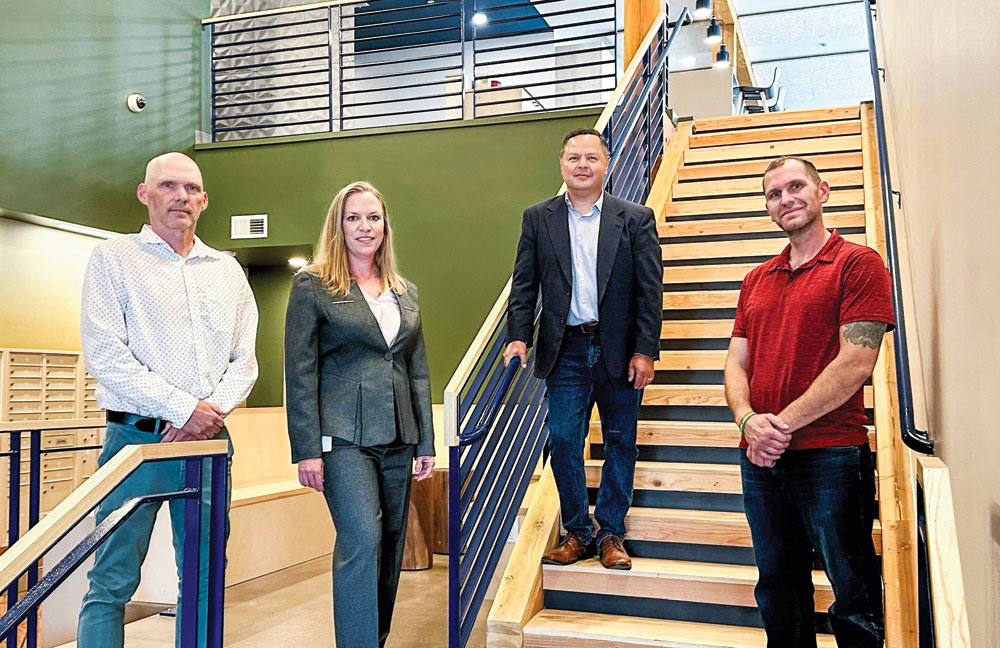
“It has been an incredible journey,” says Kate Kerkmans, Pres. and CEO of the Brain Injury Alliance, of the effort to bring 72 new units of permanent housing to East Colfax for people with brain injuries. Pictured left to right: Mike Rooney, Dir. Of Clinical Services; Kerkmans; Jeff Martinez, Pres. of Brothers Redevelopment, and Grant Williams, Community Manager.
A recent study conducted by the University of Denver’s Center for Housing and Homelessness Research (CHHR) has shed light on the pervasiveness of traumatic brain injury (TBI) among people experiencing homelessness. The study showed that 71 percent of homeless individuals suffer from a traumatic brain injury (TBI). This figure dwarfs the TBI rate that is experienced by the general population, which hovers around the 2-8 percent range.
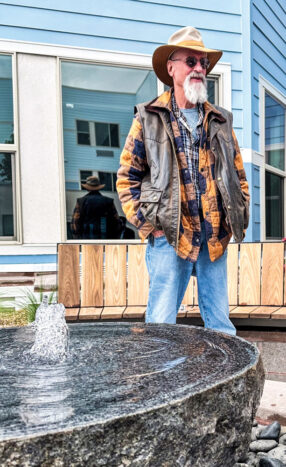
“I’m really jazzed about this place,” says resident Ken Stansberry in one of Valor’s gardens. Divorce and health issues had left him unhoused for two years, but he says “the good Lord’s blessed me.”
To address this critical issue, a new four-story, 72-unit apartment building called Valor on the Fax welcomed its first tenants in April 2023. Resident Christiana Collins had been unhoused for eight years. She recently planted sunflowers. “Sunflowers bring me luck wherever I go,” she says with a smile. Sunflowers. Roots. Home.
The Valor on the Fax is a culmination of five years of public and private sector efforts. Valor is located at 7900 East Colfax Ave. and the building will “make a dent” in the tremendous need for housing and supportive services for those with TBI or related disabilities, says Kate Kerkmans, President and CEO of the Brain Injury Alliance of Colorado (BIA).
Motor vehicle accidents and falls are the most common causes of TBI, but anoxia or oxygen loss (e.g. through stroke, aneurisms, near-drowning, and suicide attempts) can also lead to a brain injury. The BIA staffs and provides services at Valor, including support groups, peer mentorship, mindfulness classes, art and music therapy, and a Self-Advocacy for Independent Life program. Public school children residing at Valor have a staff person who can help them with their Individualized Education Plans, bus passes, and other needs.
This vision originated in 2017 in a vacant parking lot at East Colfax and Trenton. “A herculean effort,” is how Jeff Martinez, President of Brothers Redevelopment, describes the Valor project. Brothers Redevelopment built Valor and manages the property, while Shopworks Architecture ensured that the building’s design complements Park Hill’s aesthetics. On the Trenton exterior, the facade transitions to bricks and archways as it moves into the existing residential neighborhood. Inside Valor, dimmed lighting, muted colors, and long lines of sight create comfortable environments and welcoming spaces.
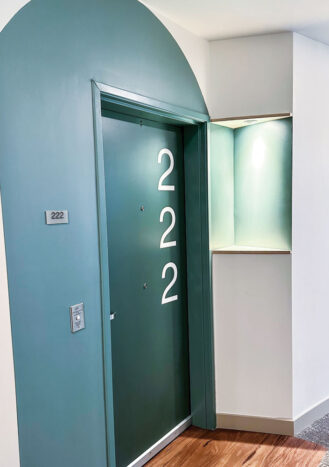
Angled front doors allow for more open lines of sight when opening a door or peering through a peephole. Each entryway has a lit niche for personalization.
“We were really lucky to be a part of the design from the beginning,” says BIA’s Kerkmans, “including trauma-informed design elements so people feel at home and safe. We were also able to include what we know of elements of brain injury and disability. Does our seating have backs and is it easy to transition into and out of, for example?” This attention to nuances is not lost on residents, who can find quiet spaces for conversation or rocking chairs for relaxation, with the motion itself regulating the central nervous system.
All tenants sign a one-year lease before they receive the keys to their furnished one-, two-, or three-bedroom apartments. Grant Williams, Brothers’ Community Manager for Valor, shares the deep emotion he witnesses when walking new residents through their units for the inspection process. “One man just sat quietly looking out the window, and didn’t respond when I asked him a question…When I looked, I saw how choked up he was.” Habits born of necessity also appear among the residents. “Sometimes they show a lot of anxiety, and they don’t want to put their bags down. They hold onto them,” says Williams. For this reason, there are no closet doors, and the one-bed units don’t have bedroom doors—it is reassuring for people who have been living on the streets to be able to see their things in the apartments.
Social isolation is a significant challenge for those with brain injuries, but it is apparent that the Valor community is already coalescing. Some talk enthusiastically about cooking classes in the works for January, and others talk about cooking meals to eat with their neighbors while relying solely on what the pantry has in stock. Tenant Ken Stansberry shares that he began walking his neighbor’s service dog Rufez, a chihuahua. Stansberry initially began walking Rufez to help out his friend, but now he just enjoys walking the dog around the area and picking up litter he finds along the way. “We all have our different issues, and we are all living in this village together. I am going to work to keep making it better,” Stansberry says.
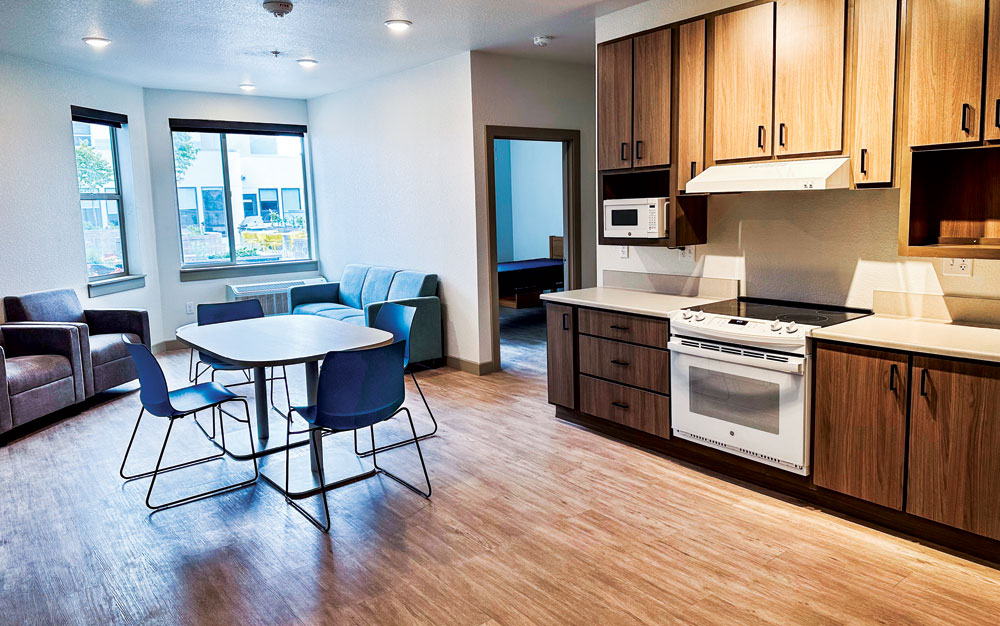
All units include basic furnishings and tenants can “shop” for home necessities among the pre-purchased and donated items stored for residents.
Fostering community was built into Valor’s design. Indoor and outdoor amenities include a shared kitchen, food pantry, communal garden, and classrooms for group activities. “When looking at assisting people who are unstably housed, it is one thing to find them housing and another to keep them housed. We are hoping that the trauma-informed design elements and staff with expertise will make this permanent supportive housing for residents,” says Kerkmans.
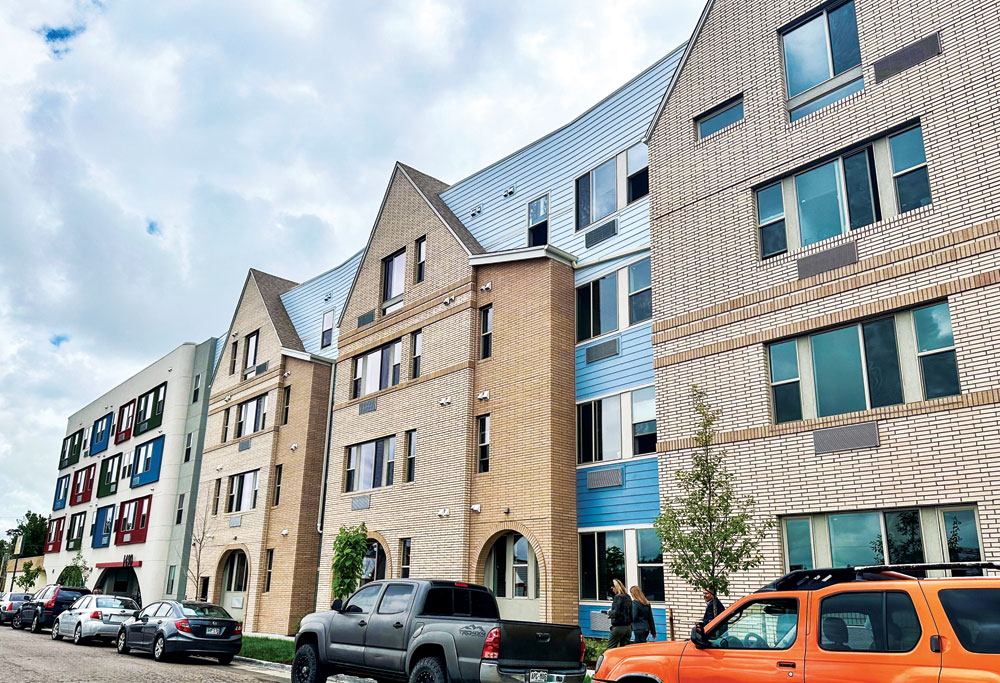
Facing the building on the Trenton side, the brick exterior and arched design elements help transition it into the Park Hill neighborhood. A secure parking garage for residents and staff is not visible from the street.
Community writ large is also fundamental to Valor. Being a “good neighbor” to businesses and other residents has been important from its inception, says Martinez. Brothers’ new office at Valor will provide a neighborhood base for housing counseling, home repair, and other services offered by Brothers. “We see this building as catalytic. The corridor needs good development,” says Martinez, who hopes that Valor becomes a model for other cities and states.
For more information, visit www.valoronthefax.com.
Front Porch photos by Christie Gosch




0 Comments